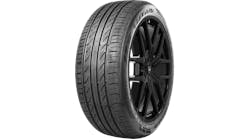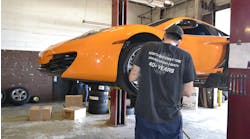Monza is popularly known as ‘the temple of speed’, being the fastest circuit on the Formula One calendar, but to everyone at Pirelli it just means ‘home’.
The Autodromo Nazionale di Monza is situated just half an hour’s drive from the company’s Milan headquarters in the Royal Villa of Monza Park and having been inaugurated in 1922 it is one of the oldest circuits of Formula One history.
The current 5.793-kilometre track is the result of many changes, but its reputation for outright speed remains, which is why the two hardest compounds in the P Zero range have been chosen: the P Zero Silver hard and P Zero White medium. This is exactly the same nomination as Spa last weekend, a track that also puts a very high energy loading through the tyres.
There are three sections of the Monza circuit that place particularly heavy demands on the tyres: the first chicane, which is characterised by heavy downhill braking, the Ascari curves – with their several rapid direction changes – and the famous Parabolica, a wide, open radius corner that puts a lot of lateral stress through the tyres.
On top of all these challenging corners, Monza also has some of the fastest straights of the year where the cars reach around 340 kilometres per hour, meaning that tyre temperatures can peak at up to 130 degrees centigrade. The high average speeds mean that there is potentially a lot of time to be gained by choosing exactly the right tyre for the conditions: consequently strategy will play a particularly important role at the final European race of the 2012 season.
Pirelli’s motorsport director says:
Paul Hembery: “Monza is probably the most important race of the year for us, as it is our chance to come home and showcase our tyres and specialized technology in front of so many of our people and the passionate Italian fans. There is a really special atmosphere to this race that is unique to Italy. Not only that, but Monza is one of the most demanding circuits that we visit all year due to the high speed and significant lateral loads on the tyres. After Spa, it is the second-highest set of forces that our tyres will experience all year. Coming to Monza directly from Spa for the first time means that the teams will be fully up to speed with the hard and medium tyres, while there is a huge amount of momentum behind the championship now, which is shaping up to become the most thrilling finale since we returned to Formula One. Ambient temperatures can be very high in Italy, which places further demands on the tyres, so we would normally expect two pit stops. Strategy turned out to be a key ingredient to success last year, with the podium places only decided on the final lap, and we would expect the same again this year. With the cars at full throttle for so long, it’s hard for anybody to gain a big lead unless they use strategy to their advantage.”
The men behind the steering wheel say:
Daniel Ricciardo (Toro Rosso): “I’m really excited about Monza, not only because it’s a track I enjoy but also because this year I’m racing for an Italian team and obviously my family has Italian roots. It’s the second biggest event of the year for me after my home race in Australia. Also making the weekend special is the fact that lots of people will be making the short trip from the Toro Rosso factory in Faenza to see us race. I’m looking forward to meeting many of the guys who work so hard for us behind the scenes. There should be a nice family atmosphere. My first time in F1 at Monza was last year and I enjoyed the weekend as it was the first time I had outqualified my team mate, who knew the track well. I also had a good race there in World Series last year, enjoying a great battle with my current team mate Jean-Eric Vergne. We will be running the hard and medium Pirellis again, just like in Spa, so we have some recent knowledge of the different compounds. This is the logical choice because actually Monza is not usually very hard on tyres, with its long straights and corners that are not too demanding. The fact we run low downforce also means the tyres don’t have to deal with too much stress. As for the number of stops in the race, we’ll have to wait and see.”
Pirelli’s test driver says:
Lucas di Grassi: “Monza is like nowhere else: the exact opposite of Monaco, for example. It’s a great circuit and the fastest place we go to all year, which is really exciting. It’s quite difficult to drive as the cars run with such low downforce that they are not always easy to control. So it’s all about the right compromise between downforce and handling. You have to be assertive under braking but all the straights and corners also mean that there are lots of good opportunities to overtake. It’s important to look after the tyres in terms of traction, as the traction areas put a lot of stress on them and if you don’t get a good drive out of the corners onto the straights then it really affects your lap time. Monza isn’t one of those circuits that takes a lot out of the tyres everywhere but instead there are one or two specific places that really put a lot of energy through them: Parabolica in particular, which is why you have to look after them. Another important place is the chicane: you have to really attack the kerbs because you can make a lot of time this way. We tested at Monza last year, and the hard and medium tyres work very well under these conditions. I’m sure we’ll be in for another great race.”
Technical tyre notes:
• Although the high speeds and fast corners are what make Monza famous, there is also some very heavy braking that places significant demands on the tyres: in the first chicane, for example, the cars decelerate from 340kph to 80kph in just 150 metres. At those low speeds, the tyres have to provide all the mechanical grip to get the car around the corner. The cars spent around 75% of the lap on full throttle and about 15% hard on the brakes.
• With the highest average lap speed of the year, the cars run the lowest downforce all season at Monza, with teams developing a specific aerodynamic package to minimise drag. In order to enhance this, the teams also run a very low ride height but this can lead to some cars bottoming out over the bumps.
• During the Parabolica corner, the drivers experience 3.7g, which also places heavy demands on the tyre structure. This is enhanced by the impacts with kerbs that the tyres face at the chicane. The tyres are well-prepared for these demands though: during laboratory tests they are fired into kerbs at 260kph.


